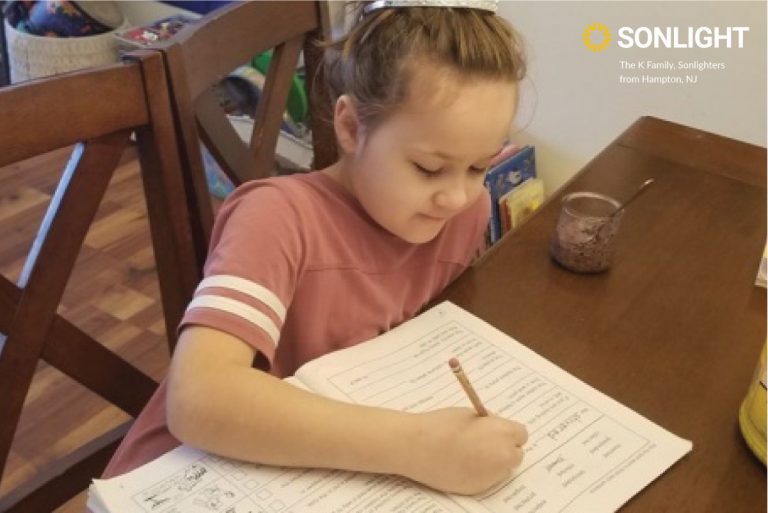If your child is learning virtually this year, they are spending a lot of time on a computer, and you may be rightly wondering...What about their handwriting? Although technology invades much of our lives these days, I still firmly believe that handwriting is a skill that needs to be cultivated.

If your child is struggling with handwriting, here are a few resources and tips that I recommend.
1. Use Boxes Instead of Lines
We all learned to write on nice and neat lines growing up, and it does absolutely look fantastic when you get those letters all lined up and uniform. However, a lot of children struggle with the fine motor skills they need to write well. So, if your child is struggling with handwriting, ditch the lines for a while.
Give them large boxes where they can practice their letters. As they get better and better at writing, begin making the boxes smaller and smaller. Then, slowly transition back to lined paper. It can really make a huge difference to give them a little more time to develop those fine motor and spatial awareness skills.
2. Try Handwriting Without Tears
Really, there are no tears with this handwriting program! Handwriting Without Tears uses plenty of tactile learning tools to help students develop their handwriting skills. From the wooden letter pieces to the fun chalkboard, their program hardly feels like work. I also appreciate how their workbooks do not overtax a developing child. With only a few repetitions on each page, gradually progressing through levels of difficulty through the years, Handwriting Without Tears makes for a very gentle introduction to handwriting instruction.
One note about this program: Similar to what I mentioned above, this program uses a two line handwriting template instead of the traditional three line template, so it takes some getting used to for us more traditional parents, but the kids pick up on it very quickly.
3. Craft It Up!
I absolutely loathe school glue. Glitter is even worse.
However, I have tried to work through my dislike of crafting materials because crafts are a great way to boost handwriting skills on the sly. Yes, your child will never know you are working to develop fine motor skills so they can write well! Isn’t it wonderful?
The muscles that are heavily used in handwriting are the tiny muscles running from the wrist to the fingers, and those can be tricky to develop. Luckily, arts and crafts provide an excellent medium to buff up those muscles. If you are looking for a full art curriculum, I really love the Artistic Pursuits program. It guides you through helping your child create beautiful works of art, all the while, working those fine motor muscles.
However, if you aren’t interested in a full lesson format, I also think that having plenty of paint brushes and paper around is a great way to both encourage your child’s creativity and imagination and prepare them for handwriting.
Doodling is also really helpful. I usually allow my children to doodle in their sketchbooks while I read aloud to them. This has helped to develop their fine motor muscles as well. While my children do a lot of doodling from their imagination, we also like Mark Kistler’s Draw Squad to give us a guide and inspire our doodles.
Of course, I have to mention sewing here as well. I think sewing is one of the best tasks to build fine motor skills. The repetition of weaving the needle in and out is just what those little writing muscles need to grow stronger. To get you started, check out Usborne Embroidery flamingo kit. The bonus for sewing is that it also makes a great activity for kids to do while you read aloud. It looks like you can have your cake and eat it too!
4. Gather Special Handwriting Tools
There’s something about tools that are so special that they can only be brought out for certain occasions, right? Creating a basket of special handwriting tools can make all the difference when it comes to helping your child practice their handwriting.
You might purchase a beautiful basket to hold supplies like
- pretty gel pens
- high-quality colored pencils
- Kwik Stiks paint pens
Every kid in the world would want to practice their letters with special tools like these!
5. Think Big Before You Think Small
Any time you introduce a new letter, always think big before you think small. Allow your child to explore the letter in a big way first.
- Try the letter on a whiteboard.
- Or let them draw letters in shaving cream spread over a cookie sheet.
As they learn the motion of the letter, begin encouraging them to make the letter smaller until it fits on a box in a piece of paper, and finally arriving at the end goal... on lined paper.
6. Solve Mazes
Invest in a few maze books, and introduce your child to an early logic experience. Of course, you’ll also be boosting their handwriting skills too, but they don’t have to know it!
Mazes encourage children to follow a curving line with one continuous stroke. It involves eye-hand coordination as well as fine motor proficiency.
Start with easy mazes such as My First Mazes and continue to work up to difficult ones like the Around the World Maze book. This is a favorite of mine because of the multicultural link! Who doesn’t love combining mazes with handwriting development and world history/geography?
If your child is struggling with handwriting, or if you are just committed to showing them the art of handwriting while they are in a mostly-virtual situation, try one or some of these resources and tips. I think you will find them helpful. But most of all, enjoy your time at home with your child! These years are fleeting quickly, and it’s our job to redeem the days.
If you'd like to talk to Advisor about what you feel are gaps in your child's handwriting ability, make your appointment here.








